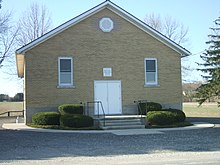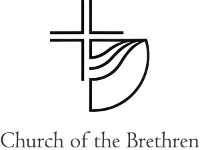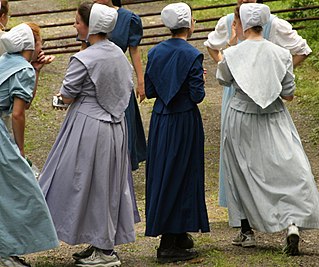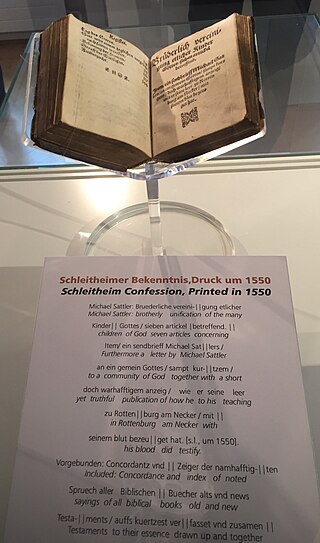
The Reformed Mennonite Church is a Conservative Anabaptist denomination of Christianity that officially separated from the main North American Mennonite body in 1812.

The Reformed Mennonite Church is a Conservative Anabaptist denomination of Christianity that officially separated from the main North American Mennonite body in 1812.
The Reformed Mennonite Church was founded on May 30, 1812, in Lancaster County, Pennsylvania, under the leadership of John Herr, the son of Francis Herr, a Mennonite who had been expelled from the church. Herr split from the main Mennonite Church on the premise that the Church leaders were deviating from the original teachings of Menno Simons, and thus deviating from the true foundation of Jesus Christ. The new denomination retained the name "Mennonite" and identified itself as the only true Mennonite movement. Others, however, referred to followers of Herr as "New" Mennonites or "Herrites", and subsequently as "Reformed" Mennonites, which eventually became the denomination's official name. [1]
The Church reached its peak membership in the mid-nineteenth century, at which time it included up to 3,000 members in Ontario and eight U.S. states. [2]
It has experienced two divisions in its nearly 200-year history. In 1917, three congregations located in Huron, Richland, and Lucas counties in Ohio (along with a few members in Ontario) formed the New Reformed Mennonite Church under the leadership of Minister John Miller. The cause for the split was disagreement over whether funerals should be held in cooperation with non-Reformed Mennonite ministers and over the Church's support of the American Red Cross during the First World War. [1]
The second split occurred in 1975 under Minister Willis Weaver, who organized the United Mennonite Church. [2] In 1987, the group had 17 members located in Lancaster County in Pennsylvania. [1]
Reformed Mennonites see themselves as true followers of Christ's teachings and of the teachings of the New Testament. They have retained the name taken from Menno Simons as they believe what he practiced and wrote are in the true Spirit of Christ and the teachings in the New Testament. They have no church rules, but they rely solely on the Bible and a prayerful appeal to Christ and His Spirit as their guide. The Reformed Mennonites practice nonresistance and therefore do not go to war, practice self-defense, or sue at the law. They practice the Lord's Supper and believer's baptism on confession of faith. Upon meeting, members greet with a kiss of charity as taught in 1 Peter 5. They practice feet washing as taught by Christ in John 13. They insist on strict separation from other denominations, and excommunicate former members. This practice is considered by them to be out of love and concern for the former member's soul, and to be meant to remind those who have left the faith of what they have lost spiritually. The women members dress in conservative plain garb that preserves 18th-century Mennonite details at all times, the men members do so at meetings, church gatherings, and other official functions. Regular day wear for the men is modern conservative clothing. The men do not wear beards. Higher education is not frowned upon and members are encouraged to attend university and trade school. They permit the use of automobiles, radio, television, telephones, cell phones, computers, and internet.
The membership of the Reformed Mennonite Church has been mostly declining since the death of founder John Herr in 1850.
The 1890 U.S. Census reported a membership of 1,655 in 34 congregations. By 1948, these figures had fallen to 733 and 24, respectively, and in 1958, the Church had only 616 members. By 1987, membership had further declined to 257 and in May 2000, it reached 171. A similar decline occurred in Ontario, which in 1948 had 6 congregations with 217 members. In May 2000, this figure stood at 131. [1]
As of 2000, the single largest congregations were in North Easthope and Stevensville, Ontario, with 73 and 58 members, respectively. Congregations in Illinois, Michigan, Ohio, Pennsylvania, and Tennessee were considerably smaller. [1]
Current estimates place total membership in the Reformed Mennonite Church at less than 300 serviced by no more than 10 churches. [2] [3] [4]
Milton S. Hershey's mother was a Reformed Mennonite. Robert Bear, a Pennsylvania farmer who was excommunicated in 1964 and again in 1972 has since been actively and publicly attacking the church. [4]
Reformed Mennonites have been depicted in a variety of literature from the late nineteenth and early twentieth centuries.
Leo Tolstoy, in his book The Kingdom of God is Within You , praised the religious pamphlet Non-Resistance Asserted by Reformed Mennonite bishop Daniel Musser.
Helen Reimensnyder Martin harshly portrayed the Reformed Mennonite Herrites and other Pennsylvania Dutch groups in her novel Tillie: a Mennonite Maid (1904), a novel which provoked cries of misrepresentation from those who resented her depictions. Early in the story a young girl of Pennsylvania Dutch, but not Mennonite, background, joins a Reformed Mennonite group after listening to a funeral sermon but is excommunicated within a few years for allowing curls of hair to peek from her bonnet. The chapter depicting the funeral scene makes much of the Herrite prohibition of attendance at funerals of other faiths; to accommodate them, two separate funeral sermons are preached, and the conclusion of the first sermon by a Reformed Mennonite minister is the signal for the Reformed Mennonites to depart.
Anabaptism is a Christian movement which traces its origins to the Radical Reformation in the 16th century. Anabaptists believe that baptism is valid only when candidates freely confess their faith in Christ and request to be baptized. Commonly referred to as believer's baptism, it is opposed to baptism of infants, who are not able to make a conscious decision to be baptized.

Mennonites are a group of Anabaptist Christian communities tracing their roots to the epoch of the Reformation. The name Mennonites is derived from the excommunicated Roman-Catholic chaplain Menno Simons (1496–1561) from Friesland, part of the Holy Roman Empire, present day Netherlands. Menno Simons became a prominent leader within the wider Anabaptist movement and was a contemporary of Martin Luther (1483–1546) and Philip Melanchthon (1497-1560). Through his writings about the Reformation Simons articulated and formalized the teachings of earlier Swiss Anabaptist founders as well as early teachings of the Mennonites founded on the belief in both the mission and ministry of Jesus. Formal Mennonite beliefs were codified in the Dordrecht Confession of Faith (1632), which affirmed "the baptism of believers only, the washing of the feet as a symbol of servanthood, church discipline, the shunning of the excommunicated, the non-swearing of oaths, marriage within the same church", strict pacifistic physical nonresistance, anti-Catholicism and in general, more emphasis on "true Christianity" involving "being Christian and obeying Christ" as they interpret it from the Holy Bible.

The Church of the Brethren is an Anabaptist Christian denomination in the Schwarzenau Brethren tradition that was organized in 1708 by Alexander Mack in Schwarzenau, Germany during the Radical Pietist revival. The denomination holds the New Testament as its only creed. Historically, the church has taken a strong stance for nonresistance or Christian pacifism—it is one of the three historic peace churches, alongside the Mennonites and Quakers. Distinctive practices include believer's baptism by forward trine immersion; a threefold love feast consisting of feet washing, a fellowship meal, and communion; anointing for healing; and the holy kiss. Its headquarters are in Elgin, Illinois, United States.

Jakob Ammann was a Swiss Anabaptist leader and the namesake of the Amish religious movement.

Menno Simons was a Roman Catholic priest from the Friesland region of the Low Countries who was excommunicated from the Catholic Church and became an influential Anabaptist religious leader. Simons was a contemporary of the Protestant Reformers and it is from his name that his followers became known as Mennonites.

Plain people are Christian groups in the United States, characterized by separation from the world and by simple living, including plain dressing in modest clothing. Many plain people have an Anabaptist background. These denominations are largely of German, Swiss German and Dutch ancestry, though people of diverse backgrounds have been incorporated into them. Conservative Friends are traditional Quakers who are also considered plain people; they come from a variety of different ethnic backgrounds.

The Schwarzenau Brethren, the German Baptist Brethren, Dunkers, Dunkards, Tunkers, or sometimes simply called the German Baptists, are an Anabaptist group that dissented from Roman Catholic, Lutheran and Reformed European state churches during the 17th and 18th centuries. German Baptist Brethren emerged in some German-speaking states in western and southwestern parts of the Holy Roman Empire as a result of the Radical Pietist revival movement of the late 17th and early 18th centuries.
The Church of God in Christ, Mennonite, also called Holdeman Mennonite, is a Christian Church of Anabaptist heritage. Its formation started in 1859 under its first leader, a self-described prophet named John Holdeman (1832-1900), who was a baptized Mennonite. The Church of God in Christ, Mennonite is Conservative Mennonite that has distanced itself from other Conservative Mennonites because of its one true church doctrine. In 2013 the church had 24,400 baptized members.
The Brethren in Christ Church (BIC) is a Christian denomination. Falling within the Anabaptist tradition of Christianity, the Brethren in Christ Church has roots in the Mennonite church, with influences from the revivals of Radical Pietism and the holiness movement. They have also been known as River Brethren and River Mennonites. The Canadian denomination is called Be In Christ.

The Old Order River Brethren are a River Brethren denomination of Anabaptist Christianity with roots in the Radical Pietist movement. As their name indicates, they are Old Order Anabaptists.
The Rosedale Network of Churches is a Christian body of Mennonite churches in the Anabaptist tradition. Rosedale Network of Churches was originally formed in 1910 by a group of Amish Mennonites to promote unity while preserving autonomy of the local congregation.
The Evangelical Mennonite Conference is a conference of Canadian evangelical Mennonite Christians headquartered in Steinbach, Manitoba, with 62 churches from British Columbia to southern Ontario. It includes people with a wide range of cultural and denominational backgrounds.

The Mennonite Church USA is an Anabaptist Christian denomination in the United States. Although the organization is a recent 2002 merger of the Mennonite Church and the General Conference Mennonite Church, the body has roots in the Radical Reformation of the 16th century.

Anabaptist theology, also known as Anabaptist doctrine, is a theological tradition reflecting the doctrine of the Anabaptist Churches. The major branches of Anabaptist Christianity agree on core doctrines but have nuances in practice. While the adherence to doctrine is important in Anabaptist Christianity, living righteously is stressed to a greater degree.

Samuel Heinrich Froehlich (1803–1857) was an Anabaptist evangelist responsible for organizing the Evangelical Baptist Church in Western Europe, which eventually spread to become known as the Nazarenes of Eastern Europe and the Apostolic Christian Church in the United States, Mexico, Argentina and Canada. Froehlich, a young seminary student in Switzerland, experienced a dramatic conversion, causing him to come into conflict with the state-church. He was excommunicated in the aftermath of his refusal to submit to an order that required the Heidelberg Catechism to be replaced by a new rationalistic catechism. He had sympathies with the Mennonite faith, but soon became convinced they were in a lukewarm state. Some of the Reformed and Mennonite persuasions followed Froehlich and were soon known as "Neu-Taufer". They later adopted the official name of Evangelical Baptist Church.

The Dordrecht Confession of Faith is a statement of religious beliefs adopted by Dutch Mennonite leaders at a meeting in Dordrecht, the Netherlands, on 21 April 1632. Its 18 articles emphasize belief in salvation through Jesus Christ, baptism, nonviolence (non-resistance), withdrawing from, or shunning those who are excommunicated from the Church, feet washing, and avoidance of taking oaths.
Conservative Mennonites include numerous Conservative Anabaptist groups that identify with the theologically conservative element among Mennonite Anabaptist Christian fellowships, but who are not Old Order groups or mainline denominations.

Amish religious practices are reflective of traditional Anabaptist Christian theology. The Old Order Amish typically have worship services every second Sunday in private homes. The typical district has 80 adults and 90 children under age 19. Worship begins with a short sermon by one of several preachers or the bishop of the church district, followed by scripture reading and prayer, then another, longer sermon. The service is interspersed with hymns sung without instrumental accompaniment or harmony. This is meant to put the emphasis on what is said, not how it is being said. Many communities use an ancient hymnal known as the Ausbund. The hymns contained in the Ausbund were generally written in what is referred to as Early New High German, a predecessor to modern Standard German.

The Weaverland Conference, also called Horning Church or Black-bumper Mennonites, is a Christian denomination of Old Order Mennonites who use cars.
The Markham-Waterloo Mennonite Conference (MWMC) is a Canadian, progressive Old Order Mennonite church established in 1939 in Ontario, Canada. It has its roots in the Old Order Mennonite Conference in Markham, Ontario, and in what is now called the Regional Municipality of Waterloo. The Conference adheres to the 1632 Dordrecht Confession of Faith. The Markham-Waterloo Mennonite Conference is in fellowship with two similar car-driving Old Order Mennonite churches: the Weaverland Mennonite Conference and the Ohio-Indiana Mennonite Conference.